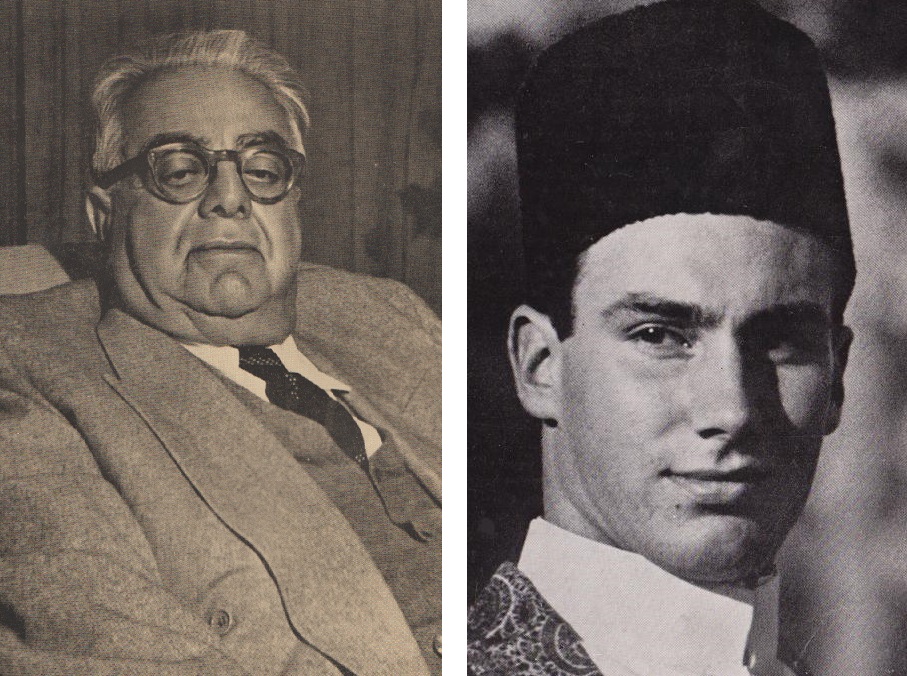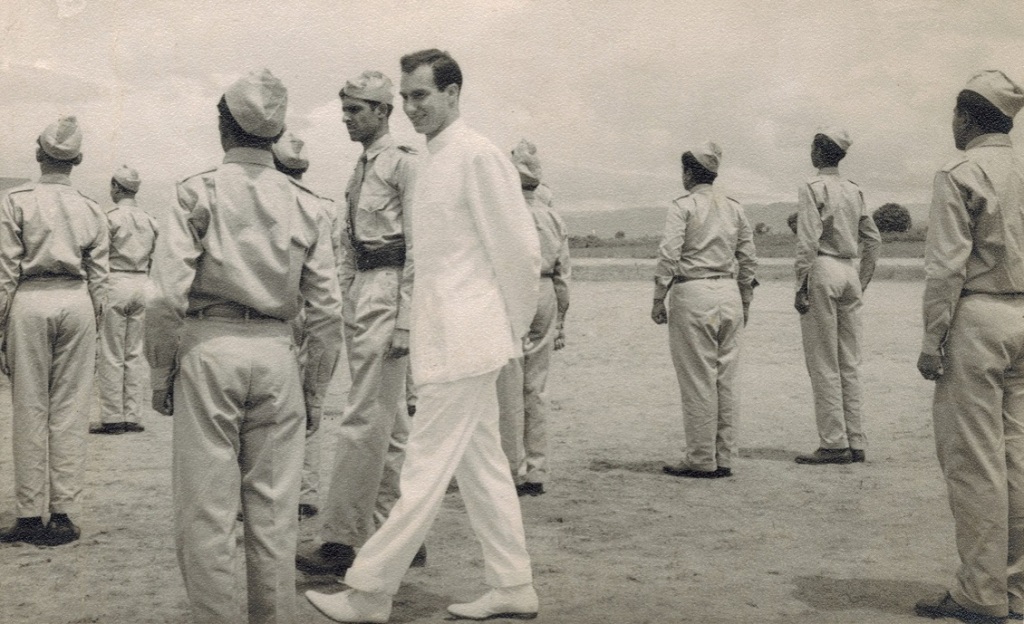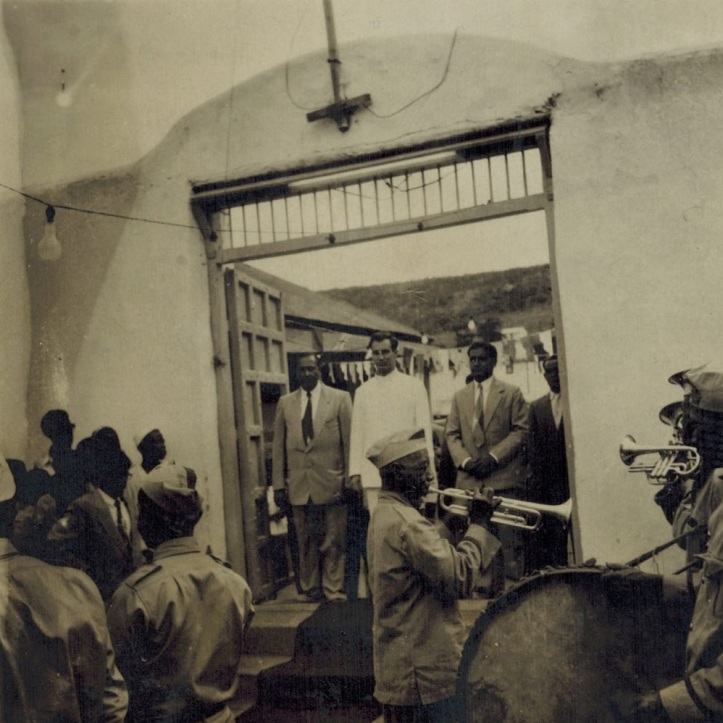
A Historic Month in Ismaili History: From One Mawla Bapa to a New Mawla Bapa; From Sadness to Jubilation
The write-up presented here has been edited and prepared by MALIK and NURIN MERCHANT from details submitted by the family of LATE MUKHI ABDULRHEMAN LALJI POPATIA.
It was one of those unique moments in Ismaili history, when a period of grief and sadness turned into “jubilation.” For 6-year-old Layla, this transition that would occur within a span of a few weeks was all beyond comprehension.
Layla’s father, Abdulrheman Lalji Popatia, and mother, Kulsum, were Mukhisaheb/Mukhianisaheba of Kigoma Jamatkhana in 1957. Mr. Hassanali Rajpar Ladak and Mrs. Sakar were Kamadiasaheb/Kamadianisaheba for the Kigoma, Ujiji, Kasulu and Kibondo jurisdiction. Kigoma Jamat was under the Aga Khan Ismaili district council which was in Tabora, a good 400 kms to the east (see map, below). Every guidance and Talika as well as other major announcements and messages came through from Tabora, where Count Gulamhussein Rajpar Ladak represented the Kigoma Jamat as the council member.

Starting sometime in June 1957, everyday at noon, Layla’s father would ask his clients/patrons who were in the shop to sit outside the shop until he came back from prayers. For 40 days, the Jamat would congregate and recite the venti Ginan ‘Ek Jire Sami Ash Tamari’ during the upstanding Tasbih. Layla remembers her mother and other ladies crying and sniffling when the Tasbih was being recited. She says she does not know if any of her friends of her age understood what was going on.
The special Tasbih at noon was for the health of Mawla Bapa, the Imam of the Time, Mawlana Sultan Mahomed Shah. He was approaching the age of 80, and had been Imam for 71 years, the longest in Ismaili history. He was very ill at that time. Layla admits that today when she hears the oft-recited venti Ginan, she remembers those sad days. There was sadness and seriousness in her home as well as in Jamatkhana. She had a sister Shirin and two brothers, Shiraz and Minaz. Some weeks later she would hear, “Mawla Bapa jomo safar gaya ane Karimshah ni nimruk thai chhe.” (Mawla Bapa has changed hands and Karimshah has been appointed as the successor). Layla gathered that Prince Karim was the new Mawla Bapa. Children like her were happy to see Mawla Bapa’s photos as the young Prince Karim in Nairobi. There was some history about his childhood — that he and his brother Prince Amyn had been in Nairobi and Kaderally Missionary was their teacher, and that Mawla Bapa had recited Idd Namaz in Nairobi when he was 7 years old. So, for a period filled with sadness, there was jubilation and celebration everywhere, and everyone’s heart was filled with immense happiness. They had been taught that Imams change physically but they are bearers of the same Noor.
Story continues after photo

Then came the news that Mawlana Shah Karim would also be visiting Kigoma as part of his Takhtnashini (ceremonial installation) visit to Dar es Salaam. The preparations began in full swing. For decorations, multi-color triangular flags attached to a long string had to be sewn, which was to be strewn in a zig zag pattern on the veranda outside the Jamatkhana enclosure.
Kigoma was a small town. It had one long avenue with acacias and mango trees on both sides. This avenue encompassed the Queens Park roundabout, and led 5 miles into Ujiji towards the north, and to the Kigoma railway station on the south. On the left of the railway station was the Kigoma Port on Lake Tanganyika, where the Belgian firm “Belbase” handled the cargo.
Starting from the beginning of the Queens Park roundabout, running parallel to the port, was an all-weather road where the District Commissioner (DC) lived. The residents lived under the DC of British Rule until Tanganyika became independent in 1961. Later in 1964, the island of Zanzibar merged with mainland Tanganyika in a political union which resulted in the country being called Tanzania.
The DC Residence was called Kaiserhoff (the Kaiser’s House), and was built during German rule. It was a huge building made of stone with lots of stairs. Rumour has it that there was a tunnel in the basement for escape, which opened up somewhere on the port of Lake Tanganyika. The Kaiserhoff was to be Mawlana Hazar Imam’s residence during his short visit to Kigoma, and the District Commissioner was to host him.
Kigoma Jamatkhana was on the northern edge of the town. Adjacent to the Jamatkhana was a school where many girls like Layla studied. Later, an official Aga Khan School was built down the road. Layla remembers Mr. Ahmedalli Remtulla and Mr. A . K. Mithani as her teachers. Behind the buildings was a Boys Boarding House where the boys from other districts did their schooling. Mukhisaheb Abdulrheman’s shop at the time was across the street from this school and his family lived behind the shop. In later years, he acquired a new shop, with residence for his family in the same building.
Story continues after photo

The preparations got underway for Mawlana Shah Karim’s visit. There were not enough local boys to make a large enough Boys Scouts team, so a few boys from Tabora were called in to add to the group. There were enough girls for the Girl Guides team.
As part of the preparation, meetings were held with Tabora Officials, Muslim Leaders of Ujiji as well as the DC. The town of Ujiji is well known in history because it is the village near Lake Tanganyika where Henry Stanley met Dr. David Livingstone in the 1870’s. The Kigoma Jamatkhana got a fresh coat of paint. The Boy Scouts and Girl Guides practiced their marches, and were shown where to stand and how to salute. Mukhiani and Kamadiani were to arrange for the food – everything was to be from scratch as there were no restaurants nor caterers in Kigoma.
Count Ladak lent his car to use for this occasion, and it was decided that his daughter Zarina R. Ladak would drive the car. Among the many observations that Mawlana Hazar Imam made upon his departure, one was that he found the lady driving the car very interesting. He was also impressed with the dinner reception that was given on-board the moving S.S. Liemba. Layla’s mother had mentioned to her that at the airport when Mawlana Hazar Imam was leaving, he asked her, “Mukhiani aapko photo nahi mangta hai?” (Mukhiani, wouldn’t you wish to have a photo taken?) They then had a photograph taken with Mawlana Hazar Imam.
In Jamatkhana, Mawlana Hazar Imam graced children with names. Mawlana Hazar Imam also conducted a few religious ceremonies in Kigoma. During his stay, he also met with Muslim leaders at Ujiji.
Kigoma’s Mukhisaheb Alijah Abdulrheman L. Popatia and Mukhianisaheba Alijani Kulsum A. Popatia
Barakah expresses its deep appreciation and gratitude to the family of Mukhi Alijah Abdulrheman L. Popatia (1908-1993), pictured below with his wife Mukhianisaheba Alijani Kulsum (1920 – 2009) for providing us with rare and historical collection of photographs of Mawlana Hazar Imam’s visit to Kigoma that have been preserved in the family albums since 1957. We have also included three photos from subsequent visits that Mawlana Hazar Imam made to Dar es Salaam. We express our heartfelt thanks to Mukhi Abdulrheman’s grandson, Farhan Moledina, for taking the time to digitize the photographs for publication in Barakah.

We request members of the Jamat from around the world to dig deep into their archives and old photo albums for rare and historical photographs of Mawlana Hazar Imam and his family. Please write in full confidence to Barakah’s editor, Malik Merchant, at Simerg@aol.com. All correspondence will be promptly acknowledged.
_______________________
Mawlana Hazar Imam, His Highness the Aga Khan, in Kigoma, 1957

______________________

______________________

______________________

______________________

______________________

______________________

______________________

______________________

______________________

______________________

______________________

______________________

______________________

______________________

______________________
Mawlana Hazar Imam, His Highness the Aga Khan, at Upanga Jamatkhana, Dar es Salaam, with Safai Committee Members

~~~~~~~~~~~~~~~~~~~~~
Mawlana Hazar Imam, His Highness the Aga Khan, at Aga Khan Girls Hostel, Dar es Salaam, 1966

______________________

Date posted: July 21, 2020.
Last updated: July 26, 2020 (Correction, see note below).
CORRECTION: In the original version of this article, we had incorrectly mentioned that the cargo at the port of Kigoma on Lake Tanganyika was handled by “Belbas”, an Italian company. Our attention has been drawn to the fact that the base which was known as “Belbase” — and not “Belbas” as we spelled it — was actually established by the Belgium Government to handle “the shipment of goods to and from the Belgian Congo via the rail link to Lake Tanganyika.” The correction is drawn from an interesting postscript piece on the Dar es Salaam harbour by Richard Crow. The article now stands corrected, as of July 26, 2020.
______________________
Barakah welcomes your feedback. Please complete the LEAVE A REPLY form or send your comment to simerg@aol.com if you don’t see the comment box. Your letter may be edited for length and brevity, and is subject to moderation.
Before departing this website please take a moment to visit Barakah’s Table of Contents for links to more than 200 pieces dedicated to Mawlana Hazar Imam, his family and the Ismaili Imamat.
We invite individuals who appear in the photos but are not listed in the captions, to please forward their names so that the captions can be updated. Please write to simerg@aol.com, Subject: Abdulrheman Popatia Photo Collection.
This website, Barakah, is a special project by http://www.Simerg.com and is dedicated to the textual and visual celebration of His Highness the Aga Khan and members of his family, as well as the Ismaili Imamat.
Wonderful pictures taking us back to the lives we used to lead! Thank you for sharing! Regards and Ya Ali Madad.
LikeLiked by 1 person
Thank you for everyone’s time, contribution and hard work for bringing history in pictures….. it’s truly memorable.
LikeLiked by 1 person
Beautiful photos of Mowlana Hazar Imam’s visit to Kigoma. I lived in Kigoma at that time. It refreshes my home town. Thanks to Barakah.com
LikeLiked by 1 person
Nice post.
LikeLiked by 1 person
All good photo memories!
LikeLiked by 1 person
We were living in Ujiji at the time and of course received the Deedar. Malik you are doing a fantastic job of gathering these wonderful memories and sharing. May you and your family continued to be blessed with lots of Barakas in all your endeavours. Ameen.
LikeLiked by 1 person
Credit is due to families who come forward and submit these historical photos, and I thank them from the bottom of my heart.
LikeLiked by 1 person
Beautiful nostalgic memories from the Popatia family collection. So moving, marking festive occasions and events. Many thanks goes to the Popatia family for preserving these photos and for Barakah for compiling and publishing these fantastic memories for us to enjoy now.
LikeLiked by 1 person
I have gone through this amazing and very nice presentation and do not have sufficient words to express my appreciation for the work you are doing and the good news you bring us. May Mawlabapa bless you and your family. I should like to say that it has been my happiness to have served Ranchore Lane Jamat of Karachi and Mawlana Sultan Mahomed Shah.
LikeLiked by 1 person
Good memory and history. Thanks for sharing the photos.
LikeLike
MashaAllah!!
LikeLike
This part of our history is very close to my heart.
LikeLike
If you can provide more information from your perspective that would be great! Were you in or around Kigoma at that time? What specific personal memories can you share about this period of transition from the 48th and 49th Imams, where you resided whether it was Kigoma or any other place?
LikeLike
I am a great admirer of the Aga Khan, his philanthropy and his great leadership of the Ismailis.
Having had my secondary education at the Aga Khan School in Dar es Salaam, I made a lot of Ismaili friends then and am still in contact with many of them.
I excelled in various sports at the school and have a good number of pictures of the sporting/ literary/drama during the period ending in 1960.
I am willing to share these with you and if you publish, many who were schooling then will fondly remember those golden days.
Thank you for an excellent and thoroughly enjoyable post on the Aga Khan’s visit to Kigoma. I do keep reviewing all posts received.
Ahsante sana bwana Malik. We should have coffee when you visit Toronto where I reside since migrating to Canada in 1996.
Raza Kara
Richmond Hill
Ontario
LikeLike
Thank you Raza for writing and for your thoughtful reflection on the Aga Khan.
I will be delighted to post a piece in Simergphotos if you can get a nice and varied selection of photographs of your Aga Khan School days compiled.
I will be contacting you soon about getting together for a Chai.
Malik
LikeLike
I would love to see a compilation of stories/facts put together on Varas Abdallah Tejpar who I believe was a brilliant organizer of multiple agencies for the Tanzanian Jama’at. Unfortunately, I never recorded his stories but I hope someone out there did.
LikeLike
Outstanding photo essay….Loved every image. Thank you Malikbhai for posting these photos from the collection of Mukhi Abdulrheman Lalji Popatia.
LikeLike
Fabuleux!
LikeLike
A great and inspiring narrative as well as a superb collection of historical photos. Congratulations to the family of Abdulrheman Lalji for their contribution and sharing the memories with readers around the world.
LikeLike
Superb narrative and fantastic photos of His Highness the Aga Khan’s, Mawlana Hazar Imam, visit to Kigoma.
LikeLiked by 1 person